| Article ID | Journal | Published Year | Pages | File Type |
|---|---|---|---|---|
| 3355310 | Immunology Letters | 2015 | 6 Pages |
•There was not any association of CTLA-4-318C/T polymorphism with susceptibility to T1D.•CT genotype was associated with a younger age of onset.•CT genotype was associated with poor control of HbA1c level.•CT genotype was associated with positive anti-GAD or IA-2 serum autoantibodies.
This study analyzed the association of CTLA-4-318C/T gene polymorphism with susceptibility, clinical course and laboratory findings of Type 1 diabetes (T1D). One hundred and fifty-three T1D patients and 189 healthy controls entered this study. CTLA-4-318C/T genotyping was performed by tetra-primer amplification refractory mutation system–polymerase chain reaction (T-ARMS–PCR) analysis. The allelic and genotypic frequencies of −318C/T gene polymorphism were similar in patients and controls. However, younger age, earlier age at onset, higher HbA1c levels, higher frequency of Glutamic acid decarboxylase antibodies (GADA) and Insulinoma Associated-2 Autoantibodies (IA-2A) were observed in T1D patient carriers of CT genotype. The current study demonstrates that although CTLA-4-318C/T polymorphism was not linked with a higher genetic risk for T1D, the presence of a CT genotype was associated with a younger age of onset, poor control of HbA1c level and positive anti-GAD or IA-2 serum autoantibodies in Iranian Azeri population.
